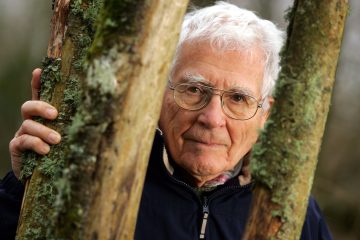Table of Contents
- Exploring Gaia Theory and Its Origins in James Lovelock’s Research
- Key Principles of Gaia Theory and Their Implications for Environmental Science
- The Evolution of Gaia Theory: Understanding Feedback Loops in Nature
- Practical Applications of Gaia Theory in Modern Sustainability Practices
- Accessing James Lovelock’s Work: Where to Find PDFs and Related Resources
- Q&A
- Concluding Remarks

Exploring Gaia Theory and Its Origins in James Lovelock’s Research
At the core of Gaia Theory lies the groundbreaking work of James Lovelock, whose multidisciplinary approach united biology, chemistry, and earth sciences. Lovelock proposed that the Earth functions as a self-regulating system, where living organisms interact with their inorganic surroundings to maintain conditions suitable for life. This interdependence between organisms and their environment suggests that the Earth itself can be viewed as a single, complex entity. Key components of this theory include:
- Homeostasis: The idea that life on Earth contributes to stabilizing conditions conducive to the persistence of life, such as temperature and atmospheric composition.
- Feedback Loops: How organisms influence their environment, establishing a cycle where changes in biotic and abiotic factors can lead to further changes.
- Collective Intelligence: The notion that the collective actions of all living beings work together to keep our planet habitable.
Lovelock’s inspiration for this theory can be traced back to his experiences as a scientist and an environmentalist. Through extensive research and the development of instruments to detect trace gases in the atmosphere, Lovelock discovered the delicate balance within Earth’s biosphere. His initial studies alongside biologist Lynn Margulis led to the recognition of symbiotic relationships and co-evolution, which further solidified the notion of an interconnected ecosystem. Notably, Lovelock’s collaboration with Margulis highlighted the importance of microbial life in sustaining planetary health.
The implications of Gaia Theory extend beyond academia; it has stirred discussions in various fields, including ecology and philosophy. By framing the Earth as a living organism, Lovelock encourages a shift in perspective regarding environmental stewardship and sustainability. This paradigm suggests that when we protect ecosystems, we are not merely safeguarding individual species, but rather ensuring the viability of life on Earth as a cohesive whole. Engaging with this concept challenges society to reconsider its place within nature, fostering a greater sense of responsibility toward our planet’s future.
Key Principles of Gaia Theory and Their Implications for Environmental Science
The Gaia Theory, formulated by James Lovelock, posits that the Earth functions as a self-regulating entity where living organisms interact with their inorganic surroundings to maintain conditions for life. This holistic approach challenges traditional views of ecology, advocating for an understanding of life and non-life as interconnected. The implications of this theory extend into environmental science, pushing us to reconsider the boundaries of biological and geological systems. By recognizing the Earth as a dynamic, adaptive system, scientists can better understand phenomena such as climate change and biodiversity loss.
One of the core principles of Gaia Theory is the concept of feedback mechanisms. These mechanisms can be positive or negative and they inherently influence the planet’s stability. For example:
- Negative Feedback: Like the regulation of carbon dioxide levels by photosynthetic organisms, which helps stabilize the climate.
- Positive Feedback: Such as melting polar ice caps which lead to decreased albedo and further warming.
The implications for sustainable practices become evident when considering the co-evolution of life and environment within the Gaia framework. This symbiotic relationship emphasizes the need for holistic approaches to conservation. Actions such as:
- Preserving biodiversity to support ecosystem health.
- Restoring natural habitats to enhance resilience.
- Implementing regenerative agriculture to foster soil health.

The Evolution of Gaia Theory: Understanding Feedback Loops in Nature
The Gaia Theory, conceptualized by James Lovelock in the 1970s, revolutionized our understanding of Earth’s systems by suggesting that biological processes interact with the non-living components of the planet to create a self-regulating system. This idea highlighted the feedback loops that operate within these systems, where the outputs of one process serve as inputs for another, fostering stability and resilience in the ecosystem. For example, the way plant life regulates atmospheric CO2 levels through photosynthesis is a prime illustration of these loops, maintaining balance and supporting life on Earth.
The recognition of feedback loops in nature underscores the interconnectedness between living organisms and their environment. These loops can be classified into two primary types: positive feedback loops, which amplify changes, and negative feedback loops, which counteract them. To better understand this dynamic, here’s a brief overview:
| Loop Type | Example | Impact |
|---|---|---|
| Positive Feedback | Melting Arctic Ice | Increased warming and further melting |
| Negative Feedback | Cloud Formation | Regulates temperature by reflecting sunlight |
As we delve deeper into the ramifications of Gaia Theory, it becomes evident that these feedback mechanisms play a crucial role in climate regulation, nutrient cycling, and maintaining biodiversity. Lovelock’s perspective encourages an appreciation for the delicate balance of ecosystems and the need for sustainable practices. By recognizing the impacts of human activity on these loops, we enhance our understanding of how our actions can disrupt ecological equilibrium, emphasizing the importance of environmental stewardship in preserving the intricate web of life. To grasp the full implications of the Gaia Theory, studying these interactions is essential for both scientists and environmental advocates alike.

Practical Applications of Gaia Theory in Modern Sustainability Practices
The Gaia Theory, introduced by James Lovelock, presents a revolutionary perspective on the interdependence of all life forms and their environment. This holistic approach underlines that the Earth functions as a self-regulating entity. In modern sustainability practices, this theory is utilized to promote strategies that encourage equilibrium between human activities and ecological systems. For instance, the concept is applied in urban planning where ecosystems are harmoniously integrated into city designs, allowing for green spaces that not only enhance aesthetics but also improve air quality and biodiversity.
Moreover, businesses are increasingly recognizing the importance of adopting Gaian principles in their operations. This includes implementing circular economy practices where waste is minimized, resources are reused, and ecosystems are regenerated. By viewing business processes through the lens of Gaia Theory, companies can develop sustainable supply chains that support not only their economic goals but also contribute positively to the environment. Examples of such practices include the use of biodegradable materials, regenerative agriculture, and sustainable sourcing of raw materials that prioritize ecological health.
Furthermore, educational institutions are embracing the Gaia perspective to instill a sense of responsibility toward environmental stewardship in future generations. Curricula that incorporate sustainability topics encourage students to think critically about their relationship with the planet. Programs that foster community-based solutions, such as local clean-up events or conservation initiatives, engage students directly with their surroundings, reinforcing the idea that collective action can lead to sustainable change. Emphasizing the interconnectedness of life not only shapes environmental literacy but also inspires innovative solutions to global challenges.

Accessing James Lovelock’s Work: Where to Find PDFs and Related Resources
For those interested in the profound ideas of James Lovelock, accessing his works has become increasingly straightforward. Numerous platforms host a variety of resources that delve into the Gaia Theory and its implications. Some recommended platforms include:
- Academia.edu: A repository where many scholars upload their papers, including key insights from Lovelock’s research.
- ResearchGate: This social networking site enables researchers to share papers and collaborate, featuring numerous shared studies on Gaia Theory.
- Google Scholar: A powerful search engine for scholarly articles that often links to downloadable PDFs of Lovelock’s works.
In addition to academic databases, several online libraries and repositories offer a treasure trove of resources. Websites like Internet Archive and Project Gutenberg might host some of Lovelock’s works or related texts. Furthermore, university libraries often grant access to PDF versions or printed copies of his seminal books and papers. Here’s a simple table summarizing useful websites to check for PDF resources:
| Website | Type of Resource |
|---|---|
| Academia.edu | Research Articles |
| Google Scholar | Academic Papers |
| Internet Archive | Books & Articles |
| Project Gutenberg | Public Domain Texts |
To further enhance your understanding of Lovelock’s groundbreaking theories, consider exploring podcasts or webinars dedicated to ecological science. Many academic institutions host online lectures that feature discussions around his work. Joining communities on platforms like Reddit or Facebook can also provide you with conversations and additional resources shared by fellow enthusiasts and scholars of Lovelock’s theories.
Q&A
Q&A on Gaia Theory and James Lovelock’s PDF Works
Q1: What is Gaia Theory? A1: Gaia Theory proposes that Earth functions as a self-regulating, complex system. It suggests that living organisms interact with their inorganic surroundings to maintain conditions for life. Named after the Greek goddess of Earth, Gaia, this theory encourages a holistic understanding of the planet’s biosphere, climate, and geology.Q2: Who is James Lovelock? A2: James Lovelock is a British scientist, environmentalist, and futurist, known for formulating the Gaia Theory in the 1970s. His innovative ideas have sparked discussions on ecological balance and climate change. Lovelock’s work has crossed various disciplines, including biophysics, chemistry, and environmental science.
Q3: What can I find in the PDF-related works by James Lovelock? A3: The PDF documents often contain a range of insights, including foundational concepts of Gaia Theory, the scientific data supporting it, and discussions on human impact on the environment. Lovelock shares his thought processes and conclusions, making complex ecological ideas accessible to readers interested in the interconnectivity of life and the planet.
Q4: How can I access those PDFs? A4: Many PDFs related to James Lovelock’s works can be found through various academic databases, online libraries, or research platforms. Websites dedicated to environmental studies or Gaia Theory may also provide links. Additionally, check if local universities offer access to academic resources where these documents might be available.
Q5: Why is Gaia Theory significant today? A5: In our current climate crisis, Gaia Theory emphasizes the importance of understanding Earth as a cohesive system rather than isolated parts. This perspective fosters a sense of responsibility in caring for our planet, influencing environmental policies, conservation efforts, and sustainability initiatives essential for future generations.
Q6: What are some criticisms of Gaia Theory? A6: While Gaia Theory has been influential, it has faced criticism for suggesting that life on Earth can regulate the environment in a way that might imply an intrinsic purpose or goal. Some scientists argue that the Earth is not a self-correcting system and that ecological balances can be disrupted irreversibly by human activity.
Q7: How can I learn more about Gaia Theory? A7: To deepen your understanding, reading Lovelock’s original works, participating in online courses, or joining discussion groups focused on environmental science can be beneficial. Engaging with both supporters and critics of Gaia Theory can also provide a well-rounded perspective on its implications and relevance.
Q8: Is there a future for Gaia Theory in modern science? A8: Absolutely. As science increasingly focuses on ecological interconnectedness and sustainability, Gaia Theory provides a framework that can integrate various scientific disciplines. With ongoing climate change challenges, its principles may inspire innovative solutions in environmental conservation and policy-making.—Explore the realms of ecology, sustainability, and climate science through the lens of Gaia Theory and James Lovelock’s enlightening contributions to understanding our planet’s intricate systems.



0 Comments